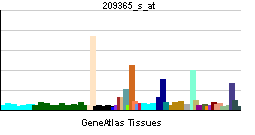ECM1
Jump to navigation
Jump to search
| Extracellular matrix protein 1 | |||||||||||
|---|---|---|---|---|---|---|---|---|---|---|---|
| Identifiers | |||||||||||
| Symbols | ECM1 ; | ||||||||||
| External IDs | Template:OMIM5 Template:MGI HomoloGene: 3260 | ||||||||||
| |||||||||||
| RNA expression pattern | |||||||||||
 | |||||||||||
| More reference expression data | |||||||||||
| Orthologs | |||||||||||
| Template:GNF Ortholog box | |||||||||||
| Species | Human | Mouse | |||||||||
| Entrez | n/a | n/a | |||||||||
| Ensembl | n/a | n/a | |||||||||
| UniProt | n/a | n/a | |||||||||
| RefSeq (mRNA) | n/a | n/a | |||||||||
| RefSeq (protein) | n/a | n/a | |||||||||
| Location (UCSC) | n/a | n/a | |||||||||
| PubMed search | n/a | n/a | |||||||||
Extracellular matrix protein 1, also known as ECM1, is a human gene.[1]
This gene encodes an extracellular protein containing motifs with a cysteine pattern characteristic of the cysteine pattern of the ligand-binding "double-loop" domains of the albumin protein family. This gene maps outside of the epidermal differentiation complex (EDC), a cluster of three gene families involved in epidermal differentiation. Alternatively spliced transcript variants encoding distinct isoforms have been described.[1]
References
Further reading
- Viliavin GD, Panchenko KP, Nishanov F, Budaev KD (1978). "[Acid-producing function of the stomach in pyloric ulcers]". Sovetskaia meditsina (12): 43–5. PMID 601588.
- Smits P, Ni J, Feng P; et al. (1998). "The human extracellular matrix gene 1 (ECM1): genomic structure, cDNA cloning, expression pattern, and chromosomal localization". Genomics. 45 (3): 487–95. doi:10.1006/geno.1997.4918. PMID 9367673.
- Johnson MR, Wilkin DJ, Vos HL; et al. (1998). "Characterization of the human extracellular matrix protein 1 gene on chromosome 1q21". Matrix Biol. 16 (5): 289–92. PMID 9501329.
- Smits P, Poumay Y, Karperien M; et al. (2000). "Differentiation-dependent alternative splicing and expression of the extracellular matrix protein 1 gene in human keratinocytes". J. Invest. Dermatol. 114 (4): 718–24. doi:10.1046/j.1523-1747.2000.00916.x. PMID 10733679.
- Hamada T, McLean WH, Ramsay M; et al. (2002). "Lipoid proteinosis maps to 1q21 and is caused by mutations in the extracellular matrix protein 1 gene (ECM1)". Hum. Mol. Genet. 11 (7): 833–40. PMID 11929856.
- Strausberg RL, Feingold EA, Grouse LH; et al. (2003). "Generation and initial analysis of more than 15,000 full-length human and mouse cDNA sequences". Proc. Natl. Acad. Sci. U.S.A. 99 (26): 16899–903. doi:10.1073/pnas.242603899. PMID 12477932.
- Hamada T, Wessagowit V, South AP; et al. (2003). "Extracellular matrix protein 1 gene (ECM1) mutations in lipoid proteinosis and genotype-phenotype correlation". J. Invest. Dermatol. 120 (3): 345–50. doi:10.1046/j.1523-1747.2003.12073.x. PMID 12603844.
- Matsuda A, Suzuki Y, Honda G; et al. (2003). "Large-scale identification and characterization of human genes that activate NF-kappaB and MAPK signaling pathways". Oncogene. 22 (21): 3307–18. doi:10.1038/sj.onc.1206406. PMID 12761501.
- Wang L, Yu J, Ni J; et al. (2003). "Extracellular matrix protein 1 (ECM1) is over-expressed in malignant epithelial tumors". Cancer Lett. 200 (1): 57–67. PMID 14550953.
- Ota T, Suzuki Y, Nishikawa T; et al. (2004). "Complete sequencing and characterization of 21,243 full-length human cDNAs". Nat. Genet. 36 (1): 40–5. doi:10.1038/ng1285. PMID 14702039.
- Horev L, Potikha T, Ayalon S; et al. (2006). "A novel splice-site mutation in ECM-1 gene in a consanguineous family with lipoid proteinosis". Exp. Dermatol. 14 (12): 891–7. doi:10.1111/j.1600-0625.2005.00374.x. PMID 16274456.
- Liu T, Qian WJ, Gritsenko MA; et al. (2006). "Human plasma N-glycoproteome analysis by immunoaffinity subtraction, hydrazide chemistry, and mass spectrometry". J. Proteome Res. 4 (6): 2070–80. doi:10.1021/pr0502065. PMID 16335952.
- Fujimoto N, Terlizzi J, Aho S; et al. (2006). "Extracellular matrix protein 1 inhibits the activity of matrix metalloproteinase 9 through high-affinity protein/protein interactions". Exp. Dermatol. 15 (4): 300–7. doi:10.1111/j.0906-6705.2006.00409.x. PMID 16512877.
- Lim J, Hao T, Shaw C; et al. (2006). "A protein-protein interaction network for human inherited ataxias and disorders of Purkinje cell degeneration". Cell. 125 (4): 801–14. doi:10.1016/j.cell.2006.03.032. PMID 16713569.
- Han B, Zhang X, Liu Q; et al. (2007). "Homozygous missense mutation in the ECM1 gene in Chinese siblings with lipoid proteinosis". Acta Derm. Venereol. 87 (5): 387–9. doi:10.2340/00015555-0292. PMID 17721643.
| This protein-related article is a stub. You can help Wikipedia by expanding it. |